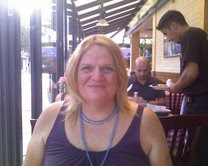Yesterday afternoon Amanda Gonzalez-Andujar, a transgender woman whose given name is Edelbuerto, was found naked and strangled in her ransacked apartment.
It's hard not to think it's a murder, although (at the time I'm writing this) the police and city officials can't yet label it as such, for legal reasons. It's equally difficult not to think that her death had something to do with her gender identity and expression. I mean, why else would her Marilyn Monroe photos have been destroyed? And why would she have been stabbed in the neck and chest several times in addition to having been strangled?
She lived and died in Ridgewood, a section of the New York City borough of Queens that's only a couple of neighborhoods away from mine. For two years, I wrote for the Times Newsweekly, the community's local newspaper. I felt as safe in Ridgewood as I have felt in any urban neighborhood in the United States. I had no fear of walking even the more remote streets of the industrial areas of the neighborhood's periphery after dark. I even left my bicycle--admittedly, my "beater"--unlocked while I covered school board meetings and other events. My wheels were as untouched as they would have been had I parked in Bhutan. I brought Tammy there once; after that, we talked about buying one of the stone or brick houses that line the neighborhood streets. I really thought I'd introduced her to an urban oasis, if not a paradise.
Then again, I was living as a man in those days, and my waist was sculpted by thirty to fifty miles of daily cycling and my shoulders from the weights I lifted every day. And my clothes, hairstyle and other markers of gender identity were completely congruent with those of other men of that neighborhood, and American culture generally. Plus--I never thought of this until now, at least not in reference to the time I spent in Ridgewood--I'm about as white as one can be.
Also, at that time, I didn't know Martin. He has lived in the neighborhood all of his life. (Technically, his place is in neighboring Glendale, which is a very similar kind of neighborhood.) And he's gay. While he seems never to have worried about meeting a fate like Amanda's, he has recounted incidents of harassment that stopped just short of physical violence. Among those with and around whom he's spent his life, he seems to have lived, and to be living, by a variation of "don't ask, don't tell." It seems that everyone knows about his sexual orientation, but he cannot talk to anyone about, say, his boyfriend(s), the way straight people can talk about their dates, lovers or spouses. He seems to find the arrangement no more bizarre than his neighbors and friends think it is.
In an environment like that, you get along by going along. The highest compliment someone can pay a neighbor is that he or she "doesn't bother anybody." And that is what someone said about Amanda yesterday.
It's not a hard sentiment to understand, especially once you've cycled the neighborhood streets and talked to local residents, most of whom are blue-collar workers and their families. People move to the fortress-like (though still very atttractive) stone and brick houses that line many of the neighborhood streets after working for years to save for the down payment. Those houses look almost exactly as they did when they were first built between 100 and 80 years ago by German immigrants. They are investments, shrines, heirlooms and fortresses, all at once, and their owners don't want them defaced. (Nowhere is graffiti more detested than it is in that part of Queens.) They help to make the neighborhood all but irresistible to those who want peace, stability and security above all else.
Those qualities make such a neighborhood attractive to transgenders, too. After Tammy and I split up and I started to live as Justine, I nearly moved there myself. It's never been known as an LGBT enclave, as parts of Jackson Heights and Astoria (where I now live) are. However, in addition to Martin, I know of a few other gays and transgenders who live there. I won't tell you who they are, as the only person I'll ever "out" is myself! Any LGBT person I mention on this blog has made his or her identity public or has been cloaked with a pseudonym.
Anyway...I never knew Amanda, so whatever I say of her thoughts or motivations is speculation on my part. Still, I am confident in saying that she probably felt some level of safety and security in living there. I'm guessing that she also lived "under cover": From the photos I saw of her, I'd say that she "passed" well enough to go "stealth." And, because most people in the neighborhood don't want to upset its serenity, they probably left her alone, even if they knew her identity.
Of course, the scenario I've just described has its own perils. One is isolation. Most people in the neighborhood are polite; some are cordial. But the extent of people's interaction with their neighbors is dictated by the amount of time they spend outside those stone and brick walls. This may have been one of the reasons why it took several days for anyone to realize that Amanda had gone missing, or that some other terrible fate had befallen her.
Now they are mourning her. So, in my own way, am I. If we--that is to say, our souls--go anywhere after this life, I hope Amanda finds love and acceptance there.
Birds of a Feather, Flock Together
4 hours ago









